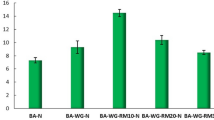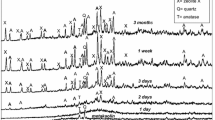Abstract
Well-reacted geopolymers with good compressive strengths (44–58 MPa) were formed from highly alkaline residue from red mud (the residue remaining after extraction of alumina from bauxite by the Bayer Process) without the addition of strength-promoting components, such as fly ash or ground slag, by adjusting the composition to an optimal SiO2/Al2O3 ratio of about 3 with silica fume. The formation of these geopolymers is extremely energy-efficient since thermal dehydroxylation of the red mud is not required. The environment of the Si and Al in the geopolymers was shown by 27Al and 29Si NMR spectroscopy to be consistent with reasonably well-reacted aluminosilicate materials, suggesting that the red mud forms geopolymers by reaction of aluminate and silicate species in a process not dissimilar to that of alkali-activated kaolin. The presence of high concentrations of iron in the red mud principally in the form of hematite did not interfere with geopolymer formation, since it was shown by XRD and Mössbauer spectroscopy to remain largely unaltered and not participate in the reaction. Analogous experiments with bauxite from which red mud is derived by alkali treatment, produce geopolymers of significantly lower strength (up to 28 MPa), suggesting that the action of the alkali during bauxite processing facilitates the formation of the geopolymer binder, possibly by increasing the reactivity of the red mud, as occurs in alkali-treated kaolinite.










Similar content being viewed by others
References
Power G, Gräfe M, Klauber C (2011) Bauxite residue issues: I. Current management, disposal and storage practices. Hydrometallurgy 108:33–45
Klauber C, Gräfe M, Power G (2011) Bauxite residue issues: II. Options for residue utilization. Hydrometallurgy 108:11–32
He J, Zhang J, Yu Y, Zhang G (2012) The strength and microstructure of two geopolymers derived from metakaolin and red mud-fly ash admixture: a comparative study. Constr Build Mater 30:80–91
Zhang M, El-Korchi T, Zhang G, Liang J, Fuel Tao M (2014) Synthesis factors affecting mechanical properties, microstructure and chemical composition of red mud-fly ash based geopolymers. Fuel 134:315–325
Zhang G, He J, Gambrell RP (2010) Synthesis, characterization, and mechanical properties of red mud-based geopolymers. J Transport Res 2167:1–9
Mucsi G, Lakatos J, Molnar Z, Szabo R (2014) Development of geopolymer using industrial waste materials. In: Proceedings of 9th International Conference on Environmental Engineering, Vilnius, Lithuania, pp. 1–8
Kumar A, Kumar S (2013) Development of paving blocks from synergistic use of red mud and fly ash using geopolymerization. Constr Build Mater 38:865–871
Dimas DD, Giannopoulou IP, Panias D (2009) Utilization of alumina red mud for synthesis of inorganic polymeric materials. Miner Process Extr Metall Rev 30:211–239
Hajjaji W, Andrejkovicova A, Zanelli C, Alshaaer M, Dondi M, Labrincha JA, Rocha F (2013) Composition and technological properties of geopolymers based on metakaolin and red mud. Mater Des 52:648–654
Vukcevic M, Turovic D, Krgovic M, Boscovic I, Ivanovic M, Zejak R (2013) Utilization of geopolymerization for obtaining construction materials based on red mud. Mater Technol 47:99–104
Ye N, Yang J, Ke X, Zhu J, Li Y, Xiang C, Wang H, Li L, Ziao B (2014) Synthesis and characterization of geopolymer from Bayer red mud with thermal pretreatment. J Am Ceram Soc 97:1652–1660
Komnitsas K, Zaharaki D (2009) Utilisation of low-calcium slags to improve the strength and durability of geopolymers. In: Provis JL, van Deventer JSJ (eds) Geopolymers: structures, processing, properties and industrial applications. Woodhead, Cambridge, p 353
He J, Jie Y, Zhang J, Yu Y, Zhang G (2013) Synthesis and characterization of red mud and rice husk ash-based geopolymer composites. Cem Concr Compos 37:108–118
Bošković I, Vukčević M, Krgović M, Ivanović M, Zejak R (2013) The influence of raw mixture and activators characteristics on red-mud based geopolymers. Res J Chem Environ 17:34–40
Kolousek D, Brus J, Urbanova M, Andertova J, Hulinsky V, Vorel J (2007) Preparation, structure and hydrothermal stability of alternative (sodium silicate-free) geopolymers. J Mater Sci 42:9267–9275. doi:10.1007/s10853-007-1910-5
Ke X, Bernal SA, Ye N, Provis LJ, Yang J (2015) One-part geopolymers based on thermally treated red mud/NaOH blends. J Am Ceram Soc 98:5–11
MacKenzie KJD, Brew DRM, Fletcher RA, Vagana R (2007) Formation of aluminosilicate geopolymers from 1:1 layer-lattice minerals pre-treated by various methods: a comparative study. J Mater Sci 42:4667–4674. doi:10.1007/s10853-006-0173-x
Perera DS, Cashion JD, Blackford MG, Zhaoming Z, Vance ER (2007) Fe speciation in geopolymers with Si/Al molar ratio of ∼2. J Eur Ceram Soc 27:2697–2703
Bell JL, Kriven WM (2010) Formation of an iron-based inorganic polymer (geopolymer). In: Sing D, Kriven WM (eds) Mechanical properties and performance of engineering ceramics and composites. Wiley, Hoboken, pp 301–312
Lemougna PN, MacKenzie KJD, Jameson GNL, Rahier H, Chinje Melo UF (2013) The role of iron in the formation of inorganic polymers (geopolymers) from volcanic ash: a 57Fe Mössbauer spectroscopic study. J Mater Sci 48:5280–5286. doi:10.1007/s10853-013-7319-4
Barbosa VFF, MacKenzie KJD, Thaumaturgo C (2000) Synthesis and characterisation of materials based on inorganic polymers of alumina and silica: sodium polysialate polymers. Int J Inorg Mater 2:309–317
Barbosa VFF, MacKenzie KJD (2003) Thermal behavior of inorganic polymers and composites derived from sodium polysialate. Mater Res Bull 38:319–331
Weng L, Sagoe-Crentsil KJ (2007) Dissolution processes, hydrolysis and condensation reactions during geopolymer synthesis. Part 1: low Si/Al ratio systems. Mater Sci 42:2997–3006
MacKenzie KJD, Smith ME (2002) Multinuclear solid state NMR of inorganic materials. Pergamon-Elsevier, Oxford
Kulshreshtha SK, Vijayalakshmi R, Sudarsan V, Salunke HG, Bhargava SC (2013) Iron oxide nanoparticles in NaA zeolite cages. Solid State Sci 21:44–50
Costa RCC, Moura FCC, Oliveira PEF, Magalhães F, Ardisson JD, Lago RM (2010) Controlled reduction of red mud waste to produce active systems for environmental applications: heterogeneous Fenton reaction and reduction of Cr(VI). Chemosphere 78:1116–1120
Johnson CE (1969) Antiferromagnetism of γ FeOOH: a Mössbauer effect study. J Phys C 2:1996–2002
Berquó TS, Imbernon RAL, Blot A, Franco DR, Toledo MCM, Partiti CSM (2007) Low temperature magnetism and Mössbauer spectroscopy study from natural goethite. Phys Chem Miner 34:287–294
Pollard RJ, Cardile CM, Lewis DG, Brown LJ (1992) Characterization of FeOOH polymorphs and ferrihydrite using low-temperature, applied-field, Mössbauer spectroscopy. Clay Miner 27:57–71
Murad E (2005) Characterization of a standard bauxite and its deferration products by Mössbauer spectroscopy. Miner Eng 18:984–986
Hill VG, Weir C, Collins RL, Hoch D, Radcliffe D, Wynter C (1978) Application of Mössbauer spectroscopy to iron-57 bauxite. Hyper Interact 4:444–447
Acknowledgements
SNMH acknowledges the tenure of a Malaysian Government (MARA) Scholarship, and JJR acknowledges the tenure of a PhD Scholarship from the Victoria University of Wellington. We are indebted to Jeanette See, Rio Tinto Alcan for kindly supplying the red mud and to Ray L. Frost, Queensland University of Technology, for the Weipa bauxite.
Author information
Authors and Affiliations
Corresponding author
Rights and permissions
About this article
Cite this article
Hairi, S.N.M., Jameson, G.N.L., Rogers, J.J. et al. Synthesis and properties of inorganic polymers (geopolymers) derived from Bayer process residue (red mud) and bauxite. J Mater Sci 50, 7713–7724 (2015). https://doi.org/10.1007/s10853-015-9338-9
Received:
Accepted:
Published:
Issue Date:
DOI: https://doi.org/10.1007/s10853-015-9338-9




